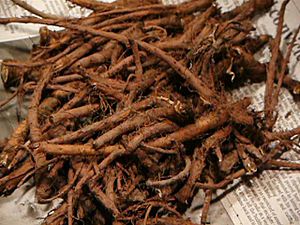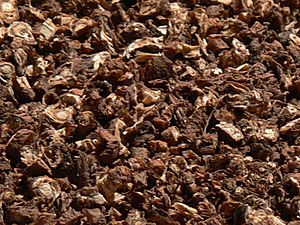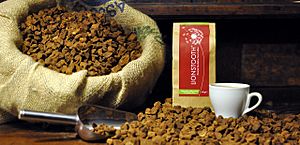Dandelion coffee facts for kids

Dandelion 'coffee' (also called dandelion tea) is a special drink. It is made from the root of the dandelion plant. When the dandelion root is roasted, it looks and tastes a bit like coffee. Because of this, many people use it as a coffee substitute. Dandelion root is used for cooking and for health reasons. Some people believe it helps clean the body.
Contents
A Look Back: Dandelion History
People have used the dandelion plant for a very long time. The ancient Egyptians, Greeks, and Romans knew about it. Also, for over a thousand years, Chinese traditional medicine has used dandelions.
In 1852, a writer named Susanna Moodie wrote about how to make dandelion 'coffee'. She learned about it from an article in a newspaper. Later, in 1886, dandelion 'coffee' was mentioned in Harpers New Monthly Magazine. By 1919, people saw dandelion root as a cheap way to make a 'coffee' drink. It has also been taught in classes about edible plants since the 1970s.
Finding and Harvesting Dandelions
When you want to harvest dandelion roots, you need to find the 'true' dandelions. These are from the Taraxacum family. Other yellow flowers, like catsear or hawksbeard, look similar. But true dandelions have leaves that grow in a circle close to the ground. Their stems are hollow like straws.
For the best dandelion coffee, look for large plants. These plants are usually 3 to 4 years old. Their main root, called a taproot, should be about half an inch thick. These taproots look a lot like pale carrots.
Dandelion roots picked in the spring taste sweeter. They are less bitter. Roots harvested in the fall are richer and more bitter.
How to Make Dandelion Coffee
You should wait until the dandelion plant is at least two years old before digging up its root. After you harvest the roots, you need to dry them. Then, you chop them into pieces. Finally, you roast them.
First, slice the roots lengthwise. Lay them out to dry for two weeks in a warm place. Once they are dry, you can roast them in an oven. After roasting, store the dried roots.
To make a cup of dandelion coffee, steep about 1 teaspoon of the roasted root in hot water. Let it sit for about 10 minutes. Many people like to add cream and sugar to their dandelion coffee.
Dandelion Root Research
Scientists are studying dandelion root. They are looking into its possible uses. Some research has explored if it could help with certain health issues.
A study in 2016 looked at colon cancer cells. It suggested that dandelion root extract might reduce the activity of these cells. Research also points to a possible decrease in colon tumors. This might happen with regular doses of dandelion root extract.
However, it is very important to be careful. Dr. Caroline Hamm is an oncologist. She is a doctor who treats cancer. She was running one of these studies. In 2017, she shared her worries. She was concerned about people getting too excited online about these studies. She was especially worried about people wanting to stop their regular medical treatments.
It's horrible if someone were to believe this and not take standard of care... And I get emails every week from people around the world thinking they want to stop their standard medicine and take [dandelion tea] instead because of these really unfounded claims. They can die if they do that.
Dr. Hamm warns that dandelion tea is not a replacement for medicine. Always talk to a doctor about your health. Never stop taking your prescribed medicine without a doctor's advice.



